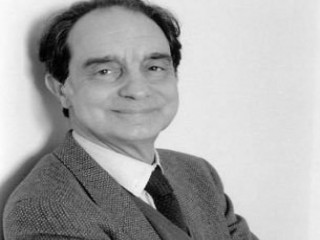
Italo Calvino biography
Date of birth : 1923-10-15
Date of death : 1985-09-19
Birthplace : Santiago de Las Vegas, Cuba
Nationality : Italian
Category : Famous Figures
Last modified : 2011-07-06
Credited as : Journalist, and writer, The Castle of Crossed Destinies, Our Ancestors trilogy
Italo Calvino was born in Cuba in 1923. His father, Mario, a botanist, was 48 when Calvino was born; his mother, formerly Eva Mameli, also a botanist, was 37. Shortly after his birth, his family returned to their native Italy. They raised Calvino on their farm in San Remo, and Mario taught at the nearby University of Turin. The lush vegetation of the San Remo area and his extensive knowledge of local flora are reflected in many of Calvino's writings.
After preparatory school, Calvino enrolled in the Faculty of Science at the University of Turin. However, soon after his matriculation, Calvino received orders to join the Italian Army. He promptly fled to the hills and joined the resistance. During the two years that Germany occupied Italy (1943-1945) Calvino lived as a partisan in the woods of the Alpi Maritime region fighting both German and Italian fascists.
At the war's end in 1945, Calvino joined the Communist Party. He also returned to the university; however, this time he enrolled in the Faculty of Letters. He began writing for left-wing papers and journals. Calvino also began to record his war experiences in stories that eventually became his highly acclaimed first novel, The Path to the Nest of Spiders (1947). Here he revealed the war as seen through the eyes of an innocent young soldier, the first of many youthful and/or naive protagonists he used to reflect life's complexity and tragedy. Considered a member of the school of neo-Realism, Calvino was encouraged to write another novel in this tradition by his literary friends, particularly writers Natalia Ginzburg and Cesare Pavese. They also invited him to join the staff of their new publishing house, Enaudi. He accepted and remained affiliated with Enaudi all his life.
However, Calvino's next books were very different. In The Cloven Viscount (1952) Calvino depicts a soldier halved by a cannonball during a crusade. His two halves return to play opposing roles in his native village. The Nonexistent Knight (1959) details the adventures of a suit of armor occupied by the will of a knight who is otherwise incorporeal. And The Baron in the Trees (1957) recounts the saga of a boy who, rebelling against the authority of his father, spends the rest of his life living in the branches of a forest. All three works, set in remote times, rely on fantasy, fable, and comedy to illuminate modern life.
By the middle of the 1950s Calvino spent most of his time in Rome, the literary as well as political hub of Italian life. He resigned from the Communist Party, tired of writing tracts for Communist periodicals and disillusioned by the spread of dogmatic Stalinism and the savage crushing of the Hungarian revolt of 1956. As the years passed, Calvino became increasingly skeptical of politics.
Publication of Italian Folktales in 1956 did much to ensure Calvino's reputation as a major literary figure. Calvino compiled a complete and authoritative collection of 200 folk tales from all regions and dialects of Italy. Critics rank this anthology along with that of the Brothers Grimm in importance and appeal.
In 1959 Calvino visited America for six months, and in the early 1960s he moved to Paris. The Watcher, a collection of three short stories, was published in 1963. While living in Paris he met Chichita Singer, an Argentinian woman who had been working for years as a translator for UNESCO (the United Nations Educational, Scientific, and Cultural Organization). They were married in 1964.
In his writing Calvino continued to "search for new forms to suit realities ignored by most writers." In the comic strip he found the inspiration for both t-zero (1967) and Cosmicomics (1968). In these pieces, which resemble science fiction, a blob-like being named Qfwfq narrates the astronomical origins of the cosmos as well as the development of the species over millenia.
The 1970s saw the publication of Invisible Cities (1972), the story of Marco Polo's voyage from Venice to Cathay, including descriptions of many fictionalized cities; The Castle of Crossed Destinies (1973), which is organized around the imagery of medieval Tarot cards; and If on a Winter's Night a Traveler (1979). This last work consists of ten unfinished novels within a novel which is itself a wild romp through the worlds of academia, publishing, and criticism.
It was also during the 1970s in Paris that Calvino became a member of "the workshop for potential literature," a group of scholars and writers who met monthly to explore the possibilities of modern literature. During this period he and Chichita became the parents of a daughter whom they named Giovana.
Calvino returned to Rome in 1980. He and his family also enjoyed a country house at Pinetta Rocca Mare near the Riviera. In 1983 Mr. Palomar was completed. Calvino turned this novel into a dramatization of a mathematical formula categorizing the actions of the title character, named for the famous observatory, at a seaside resort. The book is at once a highly comic and abstract allegory.
During these years Calvino visited the United States again. In 1975 he became an honorary member of the American Academy and Institute of Arts and Letters; in 1980 Italian Folktales was included on the American Library Association's Notable Booklist; in 1984 he was awarded an honorary degree by Mount Holyoke College; and in 1985 he was to have delivered the Norton Lectures at Harvard. However, Calvino died at 61 on September 19, 1985, in Siena, Italy, following a cerebral hemorrhage.
Italo Calvino redefined the literary forms and in so doing breathed new life into the novel, the fable, and the folktale.
















